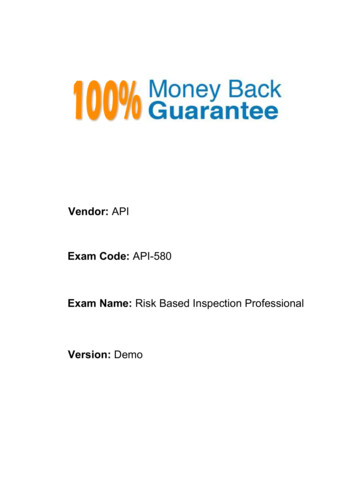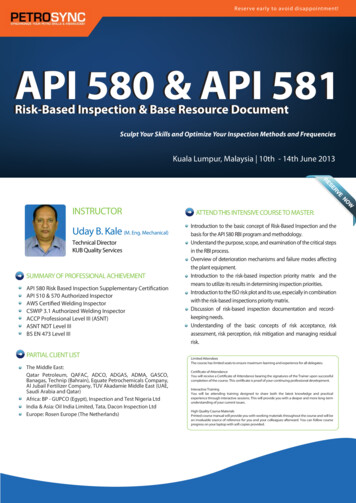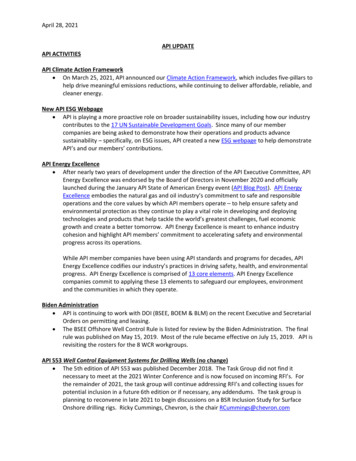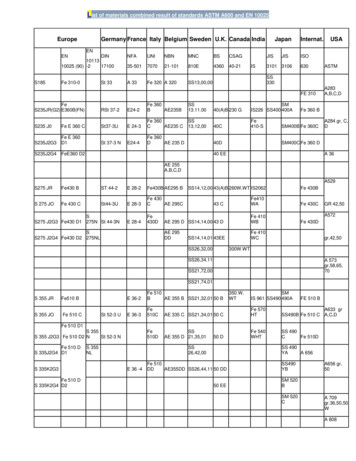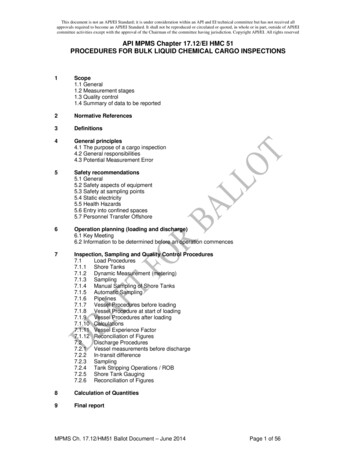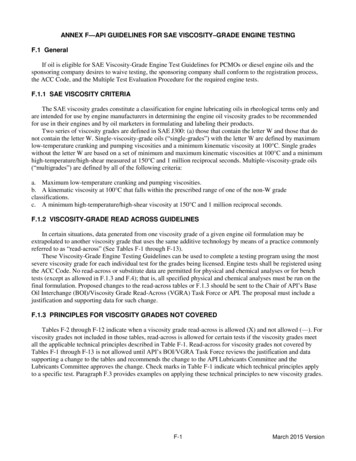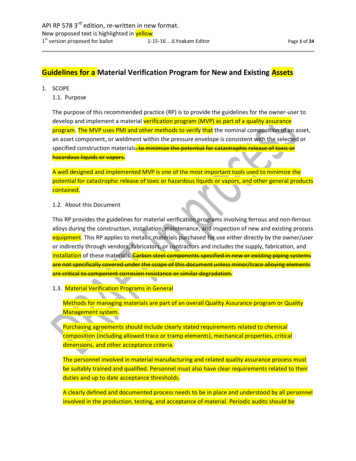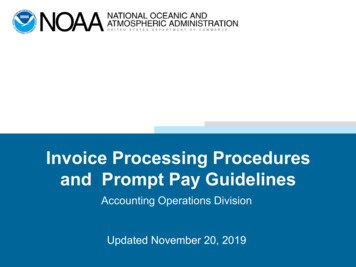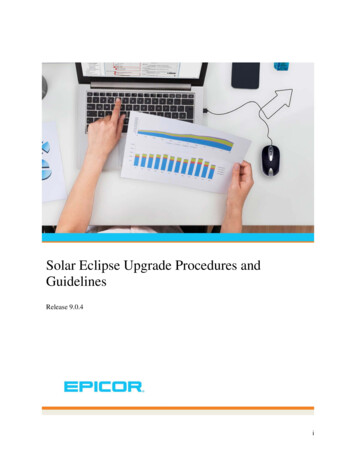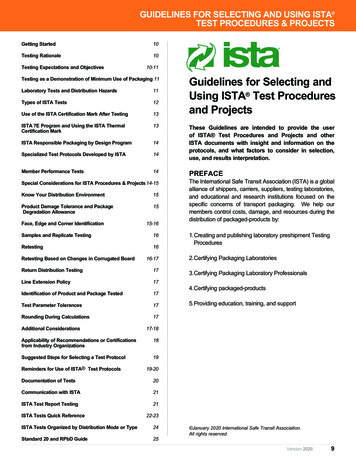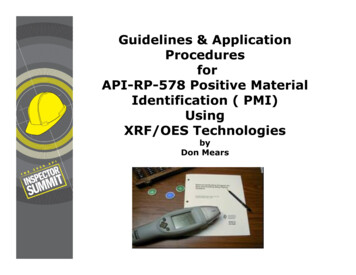
Transcription
Guidelines & ApplicationProceduresforAPI-RP-578 Positive MaterialIdentification ( PMI)UsingXRF/OES TechnologiesbyDon Mears
Presenter-Don Mears President of Analytical Training Consultants, Inc. and coordinates thesales, marketing and training program for XRF/OES Technologies. This involves the analyzers operation and training in radiation safety thatmeets local, State, Federal and International registration requirements.This includes certified report generation for proper material verificationprograms with the owners/users in the petrochemical, oil and gasindustry. Mr. Mears has worked in the oil, gas and refining industry for 30 plusyears. He held positions which included preparation and delivery oftraining presentations and has taught numerous industry coursesexplaining and applying API standards and recommended practices. This included involvement in two API work groups for revision of APIManual of Petroleum Measurement Standards Chapter 3-Tank GaugingSection 1B-"Standard Practice for Level Measurement of LiquidHydrocarbons in Stationary Tanks by Automatic Tank Gauging" and API2350 Overfill Protection for Storage Tank in Petroleum Facilities. Mr. Mears is the Author of the API RP 578 PMI Certification Course and isa certified API Training Provider.
Setting the Tone Why a “Certified API RP-578 PMI TrainingCourse” should be given ? OSHA’s Programs of-Regulation & Enforcement Process Safety Management-(PSM)-1910-119 National Emphasis Program-(NEP)-CPL 03-00-004 Chemical Safety Board-BP Texas City Refinery Fire API Standards: 570,510, &653- MechanicalIntegrity All the Reported & Unreported “ Near Misses” the Oil& Gas Industry has experienced, but because of: LuckProper PMI, InspectionTraining(RAGAGEP ) / API RP 578
Regulations and Enforcements Process Safety Management-(PSM)-1910-119-HighlyHazardous Chemicals-(HHC)-February 24, 1992 Regulation National Emphasis Program-(NEP)-CPL 03-00-004June 7, 2007 Enforcement Understand & Apply API Recommended Practice 578Positive Material Identification (PMI) GuidelinesSeptember 17, 2007 2nd Edition Approved Applying “Recognized and Generally Accepted GoodEngineering Practices”(RAGAGEP) for Inspection ofMaterial, Both in the Warehouse & Field Through PositiveMaterial Identification (PMI) Using XRF/OES Analysis
Understand OSHA‘s Definition forProcess Safety ManagementPSM To understand PSM and its requirements, both employers andemployees need to understand how OSHA uses the term“Process” in PSM. Process means any activity involving a highly hazardouschemical including using, storing, manufacturing, handling, ormoving such chemicals at the site, or any combination of theseactivities. For purposes of this definition, any group of vessels that areinterconnected, and separate vessels located in a way thatcould involve a highly hazardous chemical in a potentialrelease, are considered a single process.5
OSHA Requires Information on theEquipment in the Process Materials of construction, ( PMI ) Piping and instrument diagrams (P&IDs), Electrical classification, Relief system design and design basis, Ventilation system design, Design codes and standards employed, Material and energy balances for processes built after May 26, 1992,and Safety systems (e.g., interlocks, detection, or suppression systems). Employer shall document Equipment complies with: RAGAGEP
Inspection Scheduling by OSHA-NEPAll RefineriesCovered in the next 2 years40% in the First year60% in the Second YearAll 143 USA RefineriesOSHAHas Expandedthis to thePetrochemicalIndustry Also !!
Houston Chronicle / OSHA InterviewMarch 10, 2008Regulation and Enforcement found Slew of ViolationsHouston Chronical -OSHA NEP-3-10-08.pdf8
Why Did OSHA Establish an NEP ? According to OSHA’S Data Base; Since May 1992 (36) Fatality/Catastrophe (FAT/CAT)incidents related to HHC have Occurred Incidents include 52 Employee Deaths and 250 EmployeeInjuries, 98 required Hospitalization The number of “Refinery” Incidents Surpasses theCombined Total of the next 3 highest Industries over thesame period Chemical Manufacturing-12 FAT/CAT Industrial Organic Chemical Manufaturing-12 FAT/CAT Explosive Manufacturing-11 FAT/CAT
NEP Reasons Why According to OSHA’S Data Base : ( Examples Used ) BP Texas City Texas, March 23,2005 had:Killed-15 peopleInjured-170 people Kern Oil, Bakersfield, California, January 19,2005Killed -1 personInjured- Multiple Giant Industries Ciniza Refinery, Gallup, NewMexico, April 8,2004Killed – NoneInjured-6 peopleHospitalized-4 The above Reasons to Practice: RAGAGEP
OSHA’S NEP PROGRAMWHY THE URGENCY? Safety Bulletin from U.S. Chemical Safety and HazardInvestigation Board (CSB)—BP Texas City, TexasRefinery Fire!!!! RHUBulletin-BP Texas City.pdf
American Petroleum InstituteAPI Standard-API-570-Piping Inspection Code Standard-API-510-Pressure Vessel Inspection Code Standard-API-653-Storage Tank Inspection Code Recommended Practice-API-RP-578-Material VerificationProgram-MVP/PMIRAGAGEP
Occupational Safety and Health ActOSHA Process Safety Management-(PSM)-1910-119Highly Hazardous Chemicals-(HHC) NDT Inspection Companies-MechanicalIntegrity National Emphasis Program-(NEP)-CPL 03-00004 Explanation As it Applies to PMI
Mechanical Integrity NeedsinOil & Gas Industry Understanding HOW,WHY,& APPLYIING: ATC –API578 PMI Certification Training CourseGuidelines & Application ProceduresForPositive Material Identification (PMI)withXRF & OESTechnologies
Introduction What is the Purpose of this Course ? Purpose of the Course is to certify and re-certify any API 570 &510 inspectors for PMI Inspection requirements, and any QA/QC,Reliability Inspectors, Maintenance & Warehouse personnel. Instruction for understanding and applying API RP 578 throughan approved API Training Course, that will qualify personnel inproper Guideline and Application procedures utilizing XRF andOES technologies for PMI. The course is covered in 2 day sessions and instruction on bothclassroom theory and field testing procedures. Through Understanding API RP 578 Guidelines Through Application of proper PMI testing procedures The need and now requirement for Positive Material Identification (PMI)has dramatically grown in the past few years in refinery andpetrochemical plant operations to 100% alloy material verification intoday's risk-based QC environment.
Why do PMI?Explains How OSHA Instruction-CLP 03-00-004 NationEmphasis Program (NEP) Applies to The Refining IndustrySource: Marsh and McLennen (property protection and risk consultants)
PMI Can Prevent The Largest LossesProcess Safety Management (PSM)29CFR1910.119 With Proper Material VerificationProgram and Training“41% of the 170 largest lossesin the hydrocarbon processindustry resulted from failuresof piping systems ”Second International Symposium on the Mechanical Integrity of Process PipingJanuary 1996, Houston, TX, USAUnderstand & Apply API Recommended Practice 578Positive Material Identification (PMI) Guidelines
PMI Cycle OverviewApplying “Recognized and Generally Accepted GoodEngineering Practices”(RAGAGEP) for Inspection ofMaterial, Through Positive Material Identification (PMI)Using XRF/OES AnalysisAsset Management& Asset Recovery
Reasons Why YouShould Follow API RP578“Recognized And Generally Accepted GoodEngineering Practice” (RAGAGEP) – are engineering,operation, or maintenance activities based onestablished codes, standards, published technicalreports or recommended practices (RP) or a similardocument. RAGAGEPs detail generally approvedways to perform specific engineering, inspection ormechanical integrity activities, such as fabricating avessel, inspecting a storage tank, or servicing a reliefvalve (See CCPS [Ref. 33]).
Inspection Scheduling by OSHAAll RefineriesImportant information is found in APPENDIX A regarding the“Static List of” Inspection Priority Items (IPI) and containsquestions that the Compliance Safety and Health Officer(CSHO)’s are to address in their compliance evaluation of anemployer’s refinery “Process Safety Management” (PSM)program.It should be noted that both PMI and proper OPERATORTRAINING programs are QUESTIONS that the (CSHO) willaddress to the Owner/Operator as to compliance with theirProcess Safety Management (PSM) program.
Inspection Scheduling by OSHAAll RefineriesSection E-10Positive Material Identification (PMI)Does the employer ensure that replacement piping is suitable forits process application?Yes, No, N/AIf no, possible violations include:The employer did not follow RAGAGEP when it failed to conduct positivematerial identification (PMI) testing to ensure that construction materials ofreplacement/repaired piping were adequate for process conditions (An exampleRAGAGEP for PMI testing for existing piping systems includes but is notlimited to, API RP 578, Material Verification Program for New and ExistingAlloy Piping Systems, Section 4.3),4.3) and CSB, Safety Bulletin – PositiveMaterial Verification: Prevent Errors During Alloy Steel Systems Maintenance, BPTexas City, TX Refinery Fire);
Inspection Scheduling by OSHAAll RefineriesSection KProper Operator TrainingHave operating employees been trained on the procedures theyare expected to perform? If NO,NO Possible Violations Include:The employer did not provide initial operator training on eachspecific procedure operators are expected to perform; or1) The employer did not document the training,2) The employer did not document the means used to verifythe training, or3) The employer did not verify that the operator understandthe training.
Inspection Scheduling by OSHAAll RefineriesSection KProper Operator TrainingBased on the employer’s explanation of their management ofoperator refresher training (See document request in SectionX.E.3.o.), have the five randomly selected operating employeesreceived, completed, and understood the refresher training (Seedocument request in Section X.E.3.n.)? For each employee whooperates a process, has the employer ensured that theemployee understands and adheres to the current operatingprocedures and that the refresher training is provided at leastevery three years-- more often if necessary?YES, NO,N/A
Inspection Scheduling by OSHAAll RefineriesSection KProper Operator Refresher TrainingIf no, possible violations include:1) The employer did not provide operator refresher training atleast every three years or more often, if necessary (e.g., on afrequency consistent with that determined through consultationwith employees); or2) The employer did not document the training;3) The employer did not determine that the operator understoodthe training it received;received or4) The employer did not document how it verified the training
Inspection Scheduling by OSHAAll RefineriesIncident Investigation Report The CSHO must document in the INCIDENTINVESTIGATION REPORT the number of “Actual” and a“Near-Miss” incident which has occurred in you plant. Avery important part of this is the “Factors thatcontributed to the incident”. In section Q of AppendixA OSHA list examples and PMI and Training are apart of this list: Examples of "Factors that contributed to theincident”/“causal factors” can include, but are notlimited to:
Inspection Scheduling by OSHAAll RefineriesIncident Investigation Report Examples of "Factors that contributed to theincident”/“causal factors” can include, but are not limitedto: The employer did not design, operate, maintain, inspect, orchange (MOC) equipment or equipment systems perRAGAGEP; The employer did not train its employees in itsprocedure for transferring product from the Chemical Xintermediate tank to Reactor 23; The 3-inch reactor transfer line was replaced withoutconducting a PMI, as a result, the replaced piping that wasconstructed of an off-specification material failed in a shortperiod of time.
Conclusion“Reasons Why! This Course should be given ! ” OSHA’s Programs of-Regulation & Enforcement Process Safety Management-(PSM)-1910-119 National Emphasis Program-(NEP)-CPL 03-00004 Chemical Safety Board-BP Texas City Refinery Fire API Standards: 570,510, &653- MechanicalIntegrity All the Reported & Unreported “ Near Misses” the Oil& Gas Industry has experienced, but because of: Luck Proper PMI, Inspection Training (RAGAGEP ) / API RP 578
Guidelines and Application Procedures for API-RP578Positive Material Identification (PMI)Using XRF and OES Technologies Because of the previously discussed information andmy experience with both selling XRF Analyzers andtraining personnel in the Petrochemical and Refining Oiland Gas business, “Analytical Training Consultants, Inc.” hasproduced the API 578 PMI Certification TrainingCourse:
QuestionsDon Mears, PresidentAnalytical Training Consultants, Inc. (ATC)4801 Woodway, Suite 377WHouston, Texas 77056Cell Phone: 281-684-8881ATC Office: 713-400-1001Fax: 713-621-6488www.API578.com
API-RP-578 Positive Material Identification ( PMI) Using XRF/OES Technologies by Don Mears. Presenter-Don Mears President of Analytical Training Consultants, Inc. and coordinates the sales, marketing and training program for XRF/OES Technologies. This involves the analyzers operation and training in radiationsafety that meets local, State, Federal and International registration requirements .
![API Ballot: [Ballot ID] – API 510 & API 570, Deferrals, Rev05](/img/5/api510andapi570deferralsrev5.jpg)
